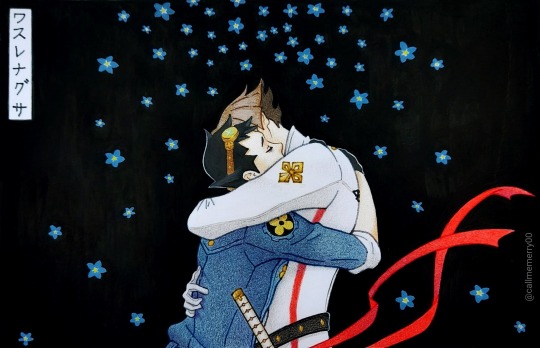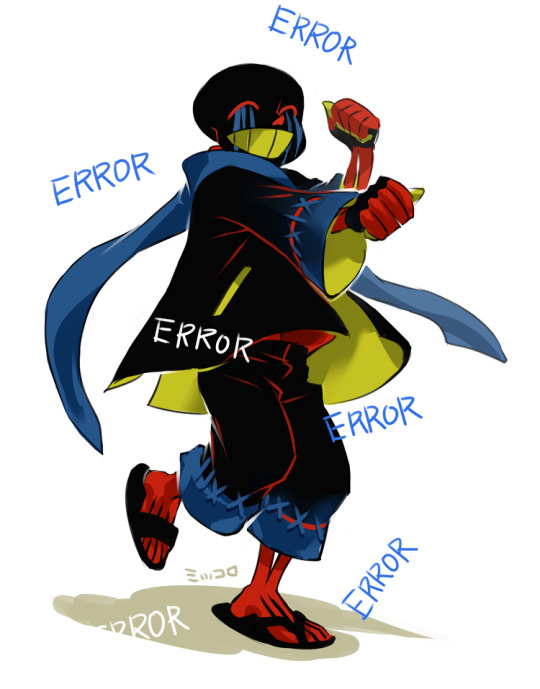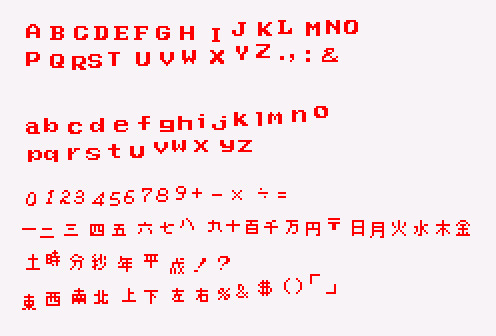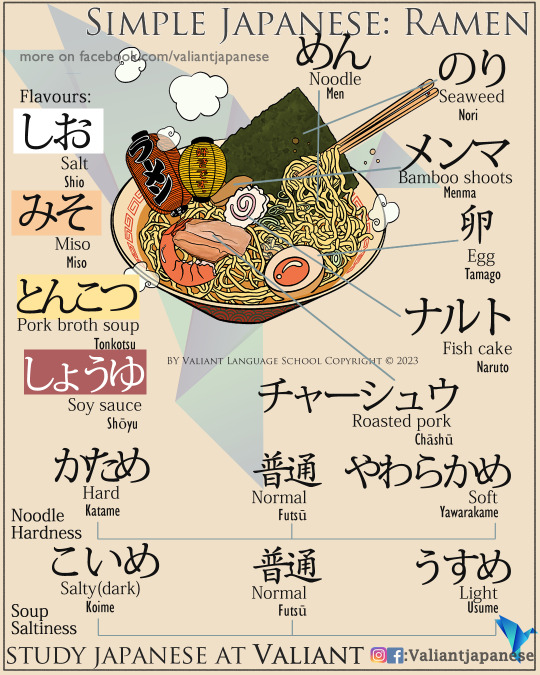#hiragana and katakana
Text
Hiragana and Katakana Part. 2
I hope everything is comming along well with your studies! Are you guys ready for part 2, because I know I am!
So lets get started.
Now that we’ve got a handling on the sounds that are the foundation of being able to speak Japanese its time to expand on that a little bit. As some of you may have noticed the letters that would make up the sounds for
D, G, P, B, J, and Z are missing. Theres just one group of sounds for us to learn after this so lets not waste any more time!

First of all take a few seconds to look at the chart above and see which characters are and aren’t included. Also look and see whats different between these characters and how they normally look.
Are you back? What did you notice?
The first thing you should’ve seen is that not all of the characters are included. It’s only the characters from the H, S, K, and T groups. The second should be the symbols on top of these letters. It's these two symbols that give us our second variety of sounds.
Those symbols are called Dakuten and Handakuten.
Dakuten
This is the quotation looking symbol that you see over the letters. Of our special letters most of them use this with the exception of one. The term for little quotations being added is usually shortened to Tenten. So if someone says you’re missing a tenten in this sense they’re probably referring to the quotation like symbol on the character.
The ones that use this are our K, S, T, and H line. So for example:
1) か Ka with the the dakuten becomes が Ga. Same with eveything else in the line.
かKa ぎGIぐGu げGe ごGo
2) さSa gets changed to ざZa. There is an exception with is (shi)し. It instead gets changed to (Ji)じ.
ざZa じJi ずZu ぜZe ぞZo
3) (Ta)た goes to (Da)だ. There are two special ones in this row, which is (chi)ち and (tsu)つ.
Chi with the dakuten is hardly used(I could be wrong), but I’ve rarely if ever come across it in this form. I cant even think of any words that use this. If you do come across it then it would be read similar to how (ji)じ. When typing it in on a keyboard you would write it as Du
As for the second one there are two ways it could be spelled out when writing it in English: (zu) or (dzu). When learning it I personally like the (dzu) one because it sounds closer to how the letter should sound, but for spelling purposes it probably looks better with the (zu) reading. When typing it on a keyboard you’d write it as Du.
だTa *ぢJi/Di *づ Zu/Dzu/Du でDe どDo
4) The last one in this list is our good friend the ‘H’ family. Now unlike the other groups, the ‘H’ family is pretty big. Of course we have the one that adds the tenten. It changes our はHa to ばBa
ばBa びBi ぶBu べBe ぼBo
This also brings us to the second symbol that changes the sound.
2. Handakuten
Luckily this symbol is only attached to one group, and that’s our ‘H’ group. Which is pretty nice since we don’t have to remember too much lol. It’s already a lot to take in. So if you see a small little circle on the letter it changes ‘H’ to ‘P’.
For example:
ぱPa ぴPi ぷPu ぺPe ぽPo
For this one, similar to how the first one had a shortened form of tenten, in this case if you forgot to write the circle on the character people might start saying maru. Maru is the Japanese word for circle.
Of course, all of this can be translated to the katakana characters too.
カキクケコ ガギグゲゴ
サシスセソ ザジズぜぞ
タチツテト ダヂヅデド
ハヒフヘホ バビブベボ パピプペポ
We still have one more set of character combinations to learn and then we can get into some sentence and basic grammar stuff! I know it’s taking a while but please bare with me lol. You can always send me asks for any sorts of questions if you’re doing self study ^^
Hiragana and Katakana part 1
Hiragana and Katakana part 3
15 notes
·
View notes
Text

#saw some kids draw leo as chun li#heehoo brain went straight to raph as ken#i have so many goddamn fucking brushes#why was my ass insisting on going full realism for these guys#when stylization is faster for me#haha (because someone told baby snack that she'll only get comic work if it's all realism all the time)#i love you rim lighting#ignoring how much my ka looks more katakana than hiragana#見ないで#the joke is it only looks like I'm back to posting#feel free to send a wealthy and feckless person here to become my patron and then maybe I will be#hehehehe his li'l seatbelt harness
329 notes
·
View notes
Text



Cherry blossoms, forget-me-nots & nerines 🌱
According to the Japanese meaning of flowers:
#1 Cherry blossoms = the impermanent nature of life
#2 Forget-me-nots = memories, true friendship
#3 Nerines = the anticipation of meeting again
#the great ace attorney#kazuma asogi#ryunosuke naruhodo#asougi kazuma#naruhodo ryuunosuke#asoryuu#tgaa#dgs#dai gyakuten saiban#tgaa2 spoilers#dgs2 spoilers#my art#pls excuse my chicken scratch handwriting#katakana is hiragana's choppy looking twin#my tgaa art
786 notes
·
View notes
Text
An aquarium toilet in Akashi, Hyōgo. Japan
Follow us for more contents ValiantJapanese
840 notes
·
View notes
Text
the meaning behind the kanji of mizu and taigen's names is literally not ever gonna leave my mind.
like are you kidding me. mizu is 水 ("water"), we all know that. but what drives me insane is that taigen is 泰源 ("peaceful origin").
so when you put them together ("tai" 泰 + "mizu" 水), you literally get "peaceful water."
MIZU ALONE IS JUST MIZU, BUT PUT TAIGEN NEXT TO HER AND IT'S MIZU, BUT AT PEACE.
ALSO, both "tai" 泰 and "gen" 源 contain the "mizu" 水 character as a radical. for those unfamiliar with japanese or even chinese, a radical basically means a building block for another character; so in this case, the kanji for "tai" and "gen" both use the kanji for "mizu" as one of their building blocks.
this is also why, while "gen" 源 can refer to any general type of origin or source, it also specifically refers to a fountainhead: a source of water, or the origin of a river or stream.
and like yeah okay i know that it's a 99.9% chance that the creators didn't even think about any of this. but STILL. the brainworms have fully taken over and i am going CRAZY.
#mizu x taigen#taigen x mizu#taimizu#blue eye samurai#like this is greatly the reason why i prefer taimizu over taizu as their ship name#bcs taizu is like. huh. what's the kanji for “zu”? it doesnt matter it's irrelevant here bcs “mizu” itself has its own kanji and meaning#the only way to spell out taizu then is to use the hiragana or katakana but in that case it wouldnt mean anything#BUT THIS???? GUYS..... IT LITERALLY MEANS “PEACEFUL WATER”.... “PEACEFUL MIZU”. LIKE CMONNNNN#taimizu in my mind = 💚💙=🌳🌊#yeah i'm scheduling this post it's been in my drafts for way too long it's time to let it roam free#fandom.rtf
194 notes
·
View notes
Text
a fellow japanese learning friend told me there's 2 major "weed-out" learning curves to japanese, and that's 1) learning hiragana and katakana and the 2) learning kanji.
but I propose that there's a 3rd difficult learning curve and that's when you're in what I've called The Intermediate Soup where you don't have any specific thing to work on anymore but you know that you aren't There Yet
#mocha speaks#japanese langblr#learning japanese#like. you already know hiragana/katakana and know enough kanji to make it through some readings#and you can speak a little and write a little#but there's no more easily defined goalposts and the ones that exist (like going by JLPT) are still nebulous#and even beyond things like JLPT you can be N1 level and still not know a lot of things.......#anyways in the Soup you just have to make your own goals but that's hard when most resources are for people not in the Soup#(i.e. still somewhat beginner focused)
136 notes
·
View notes
Text

... (^▽^;)
#I drew dancing Error in AIDN which I posted recently.#I just had a family meeting earlier#and that wore me out#so I wanted to draw something fun. (It was a really stupid agenda)#Also I changed my signature from hiragana to katakana. It might be cuter this way.#error sans
2K notes
·
View notes
Text
please reblog for a bigger size
Important update (5/10): this poll is not limited to langblrs! I realized I wrote that in the question but really I mean anyone and everyone who speaks / is learning japanese can participate!!
#japanese#learning japanese#japanese vocabulary#japan#hiragana#kanji#katakana#learn japanese#polls#tumblr polls#language blog#langblog#asian languages#language stuff#langblr
63 notes
·
View notes
Text


꧁★꧂
#text#alphabet#letters#numbers#hiragana#katakana#pixel#digital art#art#photoshop#flickr#oldweb#old web#2009
62 notes
·
View notes
Text
Learning a language is more accessible than it's ever been
Really.
There's such a wide variety of free lessons, resources, communities, and language exchanges.
This is especially true for Japanese and other languages not commonly taught in schools.
We've been running a mildly successful Discord server for a few years now (500+ members), but now we want to use our knowledge and experience to provide *free* lessons, utilizing *free* resources in every format possible, which will eventually span from N5-N1 fluency levels.
Our lesson posts will have "homework", which are apps, websites, or Youtube videos you can use to practice what you have learned, which you can pick and choose what homework format you prefer.
Don't want to download Duolingo for our first lesson's practice? Watch JapanesePod101's Youtube video on the topic instead. Don't like that? Try the link to Tofugu which covers the same topics as our lesson.
We will also cover topics such as language exposure when you can't visit the country, exercises, community games held on our Discord (we're working on Japanese Trivia Monopoly for N5 right now), streams, and more just like we always have in our Discord server!
Ready to learn Japanese, for free, regardless of skill level?
Here's the link to sign up to our Discord server.
We can't wait to see you there!
またね~

#japanese studyblr#studyspiration#study#japanese#nihongo#japan#japanese culture#japanese language#japanese learning#japanese vocabulary#learn japanese#learning japanese#kanji#hiragana#katakana
240 notes
·
View notes
Text
Hiragana and Katakana mini test 2
Hello! I'm back with another test for you all using the new set of characters we learned. Good luck!!
が 2. ぶ 3. ぱ 4. じ 5. づ 6. ぼ 7. ご 8. ぴ 9. で 10. だ
How did you do? Perfect? Great!! Let's give katakana a go! Be careful on the first two! They can be tricky so look very carefully hehe
ヅ 2. ジ 3. ペ 4. ゲ 5. ズ 6. ガ 7. ポ 8. バ 9. ザ 10. ピ
OK and finished! Let me know how you did! Was it hard? Easy? The answers are below the cut!
Hiragana answers
1. ga 2. bu 3. pa 4. ji 5. du 6. bo 7. go 8. pi 9. de 10. da
Katakana answers
1. du 2. ji 3. pe 4. ge 5. zu 6. ga 7. po 8. ba 9. za 10. pi
6 notes
·
View notes
Text
How To Read and Understand Japanese Sentences (Part 2)
To catch who is doing what; who is the main subject and who is being affected by the action; you have to pay attention to the particles.
When a person is followed by the particle は such as (田中さんは…), the speaker is trying to tell you about Mr. Tanaka.
In other situations where the speaker wants to emphasize that IT IS Mr. Tanaka who did something, the particle が would be used instead (田中さんが…)
When an object is followed by the particle を, you know the subject is doing something to this object. If I say ご飯を…, you know the subject is going to do something to the meal. Whether he is eating a meal or cooking a meal, that... you have to read the verb at the end of the sentence.
In Japanese sentences, you will never know what happened to the object or what the subject did to the object until you read the verb at the end. For instance, if I say ドレスを…, the subject could wear a dress, buy a dress, draw a picture of a dress, sew a dress, or even steal a dress, etc. There are many possibilities to what the subject could do to a dress in that sentence. As a reader, you would never know until you see the verb at the end.
And to make a simple sentence longer, Japanese people would add extra details to describe about the subject or/and the object. Let's take a look at this simple sentence below.
女の子はドレスを着ています。
The little girl wears a dress.
This is the most basic sentence structure of Subject+Object+Verb.
You have no idea where this girl comes from, what kind of dress she is wearing, what colour is the dress, etc. Now, let's make it longer.
隣に住んでいる女の子は、先週の誕生日に私からもらったかわいいピンクのドレスを着ています。
The little girl who lives next door wears a cute pink dress which she received from me as a present on her birthday last week.
Now, you have a better image in your head about the little girl and the dress she is wearing. It enhances your imagination about the character and the storyline.
Let's take another sentence.
姉はチーズケーキを食べました。
My elder sister ate a cheesecake.
Again, there is very little to feel and imagine from this short sentence. Let's make it longer by adding some details about the cake.
姉は父が仕事の後、家に帰る途中で私のために買ってきたチーズケーキをうっかり食べてしまいました。
My elder sister accidentally ate the cheesecake that my father bought for me on his way home after work.
Now, you could feel the sadness and disappointment of the speaker towards the elder sister of what she did. And you also know where that cheesecake came from.
#japanese#jlpt#jlpt n1#jlpt n2#jlpt n3#jlpt n4#jlpt n5#language#learn japanese#nihongo#study notes#study japanese#study blog#studyblr#studyspo#kanji#hiragana#katakana
39 notes
·
View notes
Text

"When in Japan - Learning Nihongo"
Learning the language will help you conveniently read the signs and interact with locals when you visit Japan.
by Jose Maria Tiquia
#art#cartoon art#cartoon#comic#comic strip#vector#drawing#cartoon illustration#illustration#illustrator#digital art#japan#japanese#nihongo#language#study#learning#hiragana#katakana#kanji#artworks#tiquiajomari
100 notes
·
View notes
Text

Simple Japanese: Ramen
Grab your latest Japanese language contents! Check
215 notes
·
View notes
Text
Japanese alphabets - Learn Hiragana & Katakana
Start learning Japanese by mastering Hiragana & Katakana. It takes only 1 week to master them with MochiKana. Try it out!

32 notes
·
View notes
Note
Why do the plushies refer to tsukasa in katakana? (ツカサクン) or was that like a onetime thing I'm not sure ...
The plushies talk exclusively in katakana actually. I think it might be to indicate a cutesy or babyish voice?
#I’m not entirely sure about things like using kana or hiragana in place of standard japanese. like how saki refers to everyone in hiragana#i think with her it might be to emphasise her gyaru style way of talking?#so i think here with the plushies talking in katakana it might be because they speak with an accent or unusual voice of some sort#asks
78 notes
·
View notes